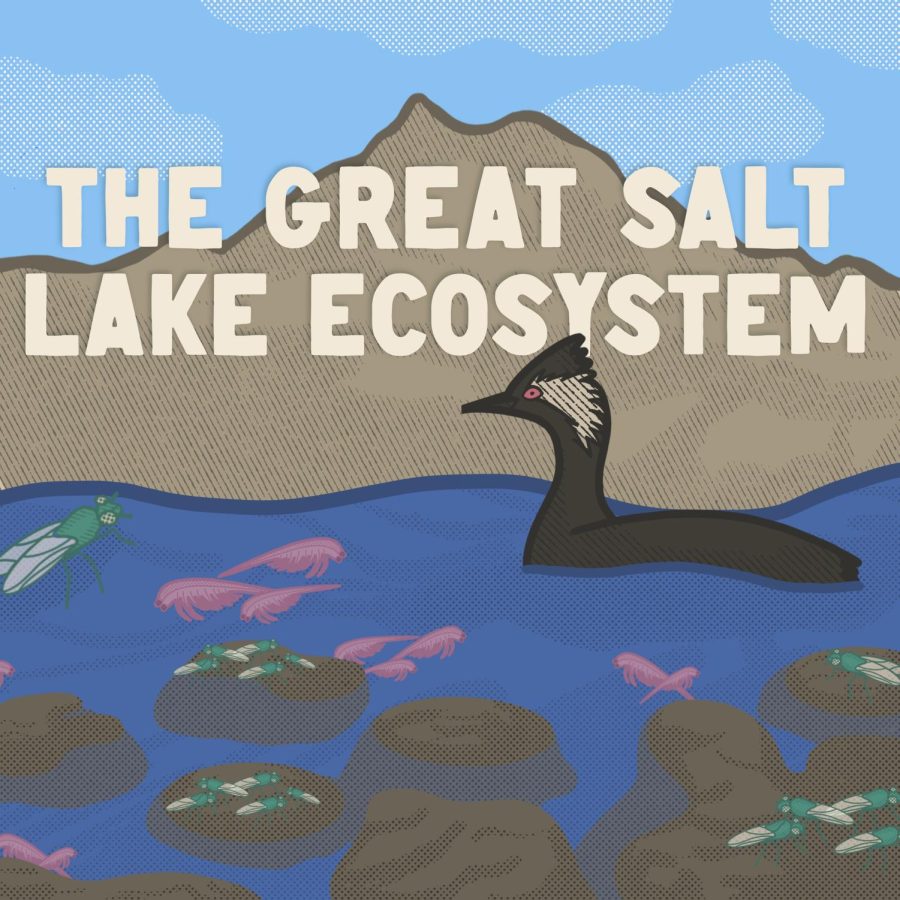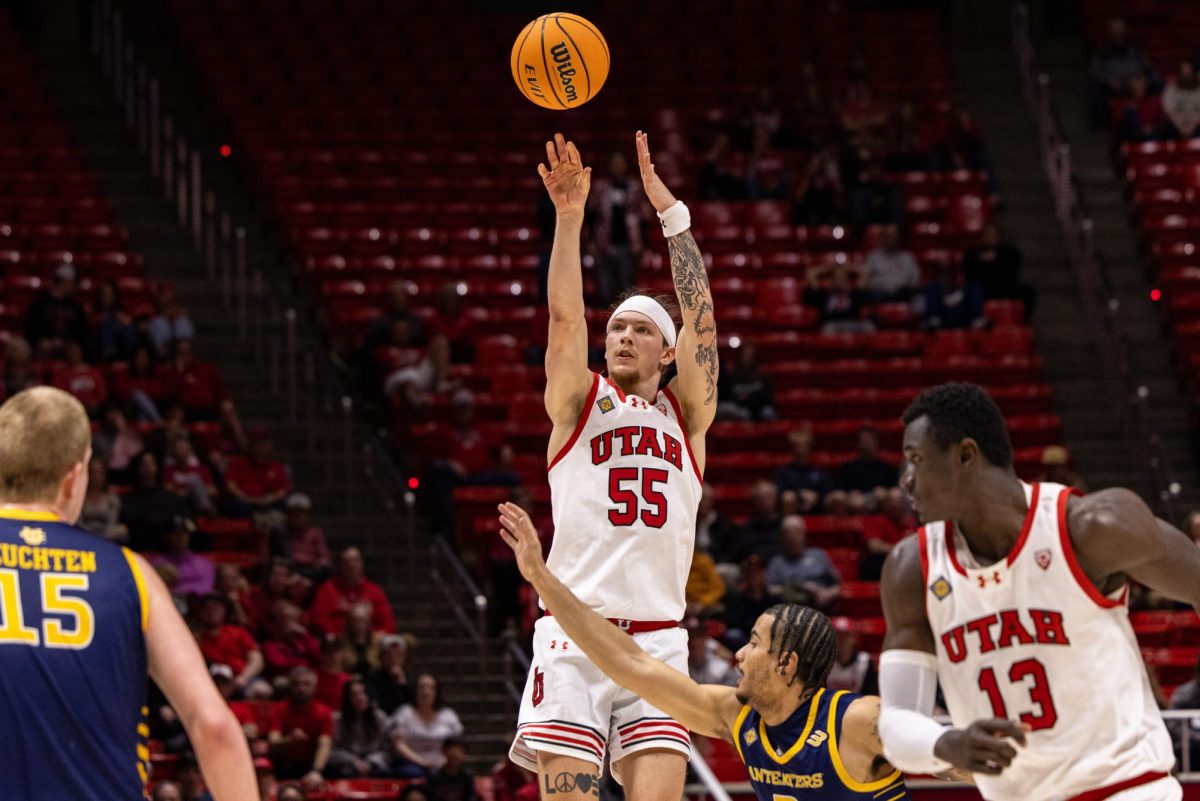Can of Worms: Episode 1 — Shrimpmageddon?
(Design by Sydney Stam | The Daily Utah Chronicle)
December 16, 2022
This is a story about the Great Salt Lake’s ecosystem and how it is being affected by the shrinking lake levels. Enjoy.
Transcript:
Ollie Hello. Hello, everyone, and welcome to the Daily Utah Chronicle’s new Narrative podcast, Can of Worms. My name is Oliver.
Cambria And my name is Cambria. Okay Ollie, what are we doing?
Ollie Every episode, we’re going to open a can of worms, and we’ll talk about something we think is important for you all to hear. We’ll interview people, go places, blend all these sounds together and tell you an interesting story.
Cambria Oh, that sounds like a good time.
Ollie I wanted to start off with a question. So, you know, the Great Salt Lake shrinking, right?
Cambria I have heard of that, yes.
Ollie Most people have, I know.
Cambria Yeah.
Oliver Well, what scares you most about the whole great Salt Lake dilemma?
Cambria You know, arsenic storms, it all drying up, and then the dust kicking up and killing us all. You know, good, easy stuff like that.
Ollie That we’re all going to die?
Cambria Yeah, that stuff.
Ollie Well, that’s valid, but have you ever thought about what will happen to the birds? Birds are really cool. I really like birds. I think the birds are going to die before you, Cambria.
Cambria Well, I could’ve told you that as well.
Ollie But when they do, that’s not a good sign for us. We talked to Katie Newburn, who’s the education and outreach director for Friends of the Great Salt Lake, and she said the same thing.
Katie Newburn You know, as the birds go, we go too. That’s not a good sign for us humans who live around the lake, to see other species who depend on it suffering.
Ollie So here’s the interesting thing. Birders are going to the Great Salt Lake and noticing less birds. And I wanted to know exactly what’s happening, like what’s causing this bird decline. So, I got interested and I started to do some research. So, Cambria, this story begins with a very important type of monkey.
Cambria Okay.
Ollie A sea monkey, actually.
Sea Monkey Ad Why,? it’s elementary, my dear Watson. You just add sea monkey eggs to prepared water. And before your eyes you’ll see them come to life. And when you feed them, they grow and grow.
Cambria Makes more sense.
Ollie I’m sure you’ve heard of them, they’re those little aquatic pets that you can watch grow in little aquariums. Maybe you had one as a kid.
Cambria Absolutely not. Didn’t.
Producer Elle I had sea monkeys as a kid.
Cambria Oh, Producer Elle!
Ollie For those listening, that’s Producer Elle.
Producer Elle Hi. Yes, I had sea monkeys when I was very little. They, you know, they have, like, little plastic tanks, and I had it on my windowsill. This is a very tragic story…
Cambria Oh, no.
Producer Elle I had them for maybe a week or two and the window was open one day and they just, like, tipped over and spilled out everywhere. And I was four and it was a really big deal, and I cried a lot.
Sea Monkey Ad Sea monkeys, the amazing instant pets for the whole family.
Cambria That’s tragic.
Producer Elle Uh huh. Yeah.
Cambria Core memory… So, what do sea monkeys have to do with this?
Ollie Well, one of the only living creatures in the Great Salt Lake is a type of sea monkey. They’re called brine shrimp. So, currently the south arm of the Salt Lake hovers around 12 to 19% [12-15%]. After some research, I found that some people are predicting that if the lake continues to dry up, the lake will keep getting saltier and could be catastrophic for the brine shrimp populations, but not just the brine shrimp. We actually talked to Cooper from the Tracy Aviary to see just how important the Great Salt Lake ecosystem is to these birds.
Cooper Farr People always say over 250 species that are relying on Great Salt Lake every year, basically.
Cambria That’s a lot of birds that rely on these little sea monkeys.
Ollie That’s what I thought. So I kept looking into it. And what I found is that the eared grebes are one of the most influenced by the brine shrimp population.
Cooper Farr An example of that would be the eared grebes come in the fall and, you know, we get 3 to 5 million of them, like up to 90% of the North American population. And they spend like 3 to 5 months here, basically just eating brine shrimp.
Ollie Ashley Kijowski, who is a wildlife biologist for the Department of Natural Resources, also told us the importance of eared grebes.
Ashley Kijowski The eared grebe, I would say, would be the number-one bird we talk about when it comes to eating brine shrimp. We see anywhere from 2 to 5 million eared grebes on the lake during the fall and spring. So, like this fall, if you went out on the lake, you would just see endless amounts of these birds. It’s pretty cool to see. And they feed on brine shrimp. And Dr. Conover at Utah State University studied eared grebes and how much they eat, like their diet and their stomach content, and figured out that each eared grebe eats around 25,000 to 30,000 brine shrimp per day.
Ollie So, brine shrimp are quite important to birds, especially eared grebe. And they also play a pretty large role in Utah’s economy. They bring in $10 to $60 million a year, depending on harvest numbers.
Cambria Okay. A $60 million industry. Who is buying these brine shrimp?
Ollie Well, interestingly enough, brine shrimp are actually a good food source for pet fish. And once harvested from the Great Salt Lake, they’re shipped all over the world for this. So, we reached out to the brine shrimp harvesters to see how this process works … but we didn’t get a response, so we started going to local fish shops to talk to people about where they got their shrimp and how they used them. First we went to PetCo and talked to Cassie.
Ollie I guess in terms of like brine shrimp as like a food source for fish, how often do people buy brine shrimp here?
Cassie from PetCo Pretty frequently. Brine shrimp are a really good option because they’re high in sodium, which helps with gill function and just overall health. High in protein as well.
Ollie She gave some pretty good info. So, if you like your fish and you want to feed them something yummy that aren’t little fish pellets, brine shrimp could be the answer. From all these stores we went to, it sounds like the Great Salt Lake is a big part of pretty much the whole brine shrimp harvesting —
Cambria The production of brine shrimp, yeah.
Ollie The production of brine shrimp. And It’s like one of the most important in the world.
Ashley Kijowski So if you go to the store and, like, buy farmed fish or shrimp, there’s a, like, 40 to 60% chance that those were raised in the Great Salt Lake. So it’s like a very cool way that Great Salt Lake is connected to the world and the aquaculture industry is just, like, super important for feeding everyone, so it’s pretty cool.
Ollie I’m walking down the aisle now of the PetSmart [PetCo] looking at all the different varieties of fish. There’s a blue sword-tailed guppy, a tequila sunrise delta guppy. You know, what look to be a genetically modified glow fish that shine in the black light. And what I’m keeping in mind throughout this fish peruse is that all of these fish, in some form or another, rely on brine shrimp in the time of their life.
Ollie But we wanted more information, so we continued looking into other stores. We were very passionate about this.
Cambria Gotcha.
Ollie We also went to Reef-On and talked to a guy that was very interested and said some crazy things about coral and growing your own coral.
Cambria Wow.
Reef-On guy Well, they’re a colony of … each mouth is an individual animal, and then their colors come from algae that is symbiotic, lives with them. And that’s called Zooxanthellae. So they have that algae inside of them and that’s what gives them like their colors and stuff. And the algae, like, helps them, I think consume sugar.
Ollie So, I’m just wondering, like, if they’re harvesting all this brine shrimp, how is it affecting the populations? And if they already could be affected by the salinity of the lake, are they, like compounding the issue by harvesting all these brine shrimp?
Cambria Oh, that’s a good point.
Ollie Ashley actually let us know if they can regulate the levels of brine shrimp every year, they can stop them from overproducing and then, like, eating up the food and dying off. That’s kind of what the issue was. But if they can regulate how much brine shrimp are being harvested and keep it at that level, then they’ll keep it at a sustainable level for all the birds.
Cambria So it is like a very nice symbiotic relationship?
Ollie Exactly.
Cambria Yeah. So how does that relationship happen?
Ollie Let me let Ashley explain.
Ashley Kijowski We have a boat and we take it out on Great Salt Lake. Typically, we have 17 sampling sites, but since the lake has gotten more shallow, we lost our two shallowest sites. So now we go to 15 sites on the lake and we take a net-haul sample. So, it’s like a big net, and you drop it down into the water column, pull it back up, and it’s made of really fine mesh so it keeps the brine shrimp eggs inside of it. We do it in the summer too, so we can count adults and everything. When we go out on the lake and we get these samples and we count the cysts, we keep track of how many are in the lake per liter. So it’s a density measurement, and we have this number of 21 cysts per liter in the water, is where we will stop the harvest. And that’s how we’ve been able to manage it. And because we manage it that way, we’ve been able to keep the brine shrimp in the lake steadily. And so, the birds when they come here every year, have brine shrimp. Whereas in the past, before we started collecting data, there’s, you know, written down stories of the lake not having any shrimp. So, I think they would go through these boom-and-bust cycles where there’d be tons of shrimp reproducing, and then they would eat all their food and crash and the birds would come here and there might not have been as many. But because we manage it and they don’t crash anymore, we’ve been able to provide birds with food consistently. So, I feel like the management of the brine shrimp on Great Salt Lake is like a huge success story.
Ollie So, like I said, I first thought the issue was all with the brine shrimp and that the brine shrimp harvesters were kind of making it worse by harvesting all these brine shrimp.
Cambria Sure.
Ollie And that isn’t the case at all. The shrimp are fine, at least for now.
Cambria So then what’s the problem?
Ollie According to the people we talked to, the brine flies are the main issue right now.
Cambria Oh.
Ollie Let me let Carly at the Great Salt Lake Institute explain what’s going on.
Carly Biedul The problem is that the — we think that there is less flies for the birds to eat. And we also think that the flies might not be as nutritious as before.
Ollie So while brine shrimp are a good food source for birds, brine flies are a much more important food source. Even Ashley agrees that this is the real issue.
Ashley Kijowski Most of our research has focused on brine shrimp. But I think now with, you know, realizing how much habitat we’re losing for brine flies, we may have to start to focus on that a little bit more.
Cambria So brine flies take the cake for important food source over brine shrimp?
Ollie Yeah, exactly.
Carly Biedul There’s not as many that are hatching, but also with the less place to pupate as the microbialites are drying up and getting exposed, then there’s just less opportunity for the flies to attach.
Cambria Okay. Wait, what are the microbi-blah-blag?
Ollie Microbialites?
Cambria That’s the one. What are those about?
Ollie So, think of them kind of like the coral of the Great Salt Lake.
Cambria Okay.
Ollie I’m sure that the guy from Reef-On would love these.
Cambria He definitely would.
Ollie They form underwater and are made up of billions of microbes that can live underwater. And these mounds of microbes are super important for the lake. They’re basically the foundation of the lake’s ecosystem.
Cambria Okay.
Ollie Here’s Katie from Friends of Great Salt Lake again.
Katie Newburn They’re the producers, you know, who photosynthesize and then convert all of that energy up the food chain. They are exposed, huge swaths of them, as a result of low water levels. And they, you know, they need to live and form in shallow water because, you know, they’re producing their energy from sunlight, so they they can’t be, you know, so deep that the sunlight doesn’t penetrate to reach them. And the brine flies are also dependent on those microbialites as a substrate that they attach to while they pupate, while they transform from their larval stage into their adult stage.
Ollie I’m pretty sure you’re getting the picture. They’re important, right? Are you learning here? Are you listening to me?
Cambria I feel like I am, yeah.
Ollie So as more of these mounds get exposed, less brine flies can use them to reproduce and feed on their nutrients. And so the population of brine flies decrease. Here’s Katie from Friends of Great Salt Lake again.
Katie Newburn As we started to see these microbialites being exposed, it was like, hey, these are the foundation of the food web. This is not going to be good, and now we’re seeing that ripple upward in the food chain.
Ollie So this is really what’s affecting the birds.
Ashley Kijowski We have seen a decline in common goldeneyes. So, those are waterfowl that stay here in the winter, and they often feed off of brine fly larvae. And so we have seen some impacts on brine fly larva abundance, and we think it’s due to the depletion of habitat. So, brine fly larvae live on microbialites at the bottom of the lake. These microbialites are becoming exposed as the lake shrinks, so they are losing habitat. And that is a concern for us because these birds depend on brine fly larvae as food. Actually, a lot of birds depend on either brine fly larvae or brine fly adults for food.
Cambria What’s the solution here?
Ollie Well, we need to save the microbialites because by doing that, we’ll save the ecosystem. But we don’t have a lot of time. It’s Katie again.
Katie Newburn It’s kind of a race against the clock to preserve the food web within the lake — like, within the next year. The lake needs a lot of water to avoid, basically, dropping another foot, which it did this year and it did the year before. We work, you know, in all of our advocacy efforts, to deliver water to the lake. That is the name of the game. And that’s really going to cushion the impacts of the rising salinity, you know, the loss and exposure of huge swaths of microbialites that are now out of the water and provide additional habitat for the birds who are coming to the lake. That really across the board, you know, that’s the solution that we need.
Ollie So without water, the lake disappears, then the microbialites, then the flies and the shrimp and then the birds. And after the birds, probably the humans. It’s a pretty dire situation. To understand the water we’re losing. It’s important to understand the geography of the lake. I’ll let Ashley explain.
Ashley Kijowski When I think of Great Salt Lake I actually think of like five different bodies of water. So, we have the north arm, which is hypersaline, pink water, right? Archaea and bacteria live there. It’s divided by the causeway. Then we have the south arm, which is typically less saline. And it ranges anywhere from like typically to like 16 or 17%. We’re at 19.4% now, so we are very salty. But then we have Farmington Bay, Ogden Bay and Bear River Bay, and those do vary in salinity. Bear River Bay is the freshest, mostly freshwater. There are fish that live in there. We have Ogden Bay and Farmington Bay, which are a little more saline, like 1 to 3%. So, it is kind of like three, you know, different lakes there. And then like we have that salty water with the brine shrimp and brine fires, but then we also have all these wetlands and those are separate from those bays. I mean, the water from those wetlands feeds into those bays, but a lot of those are impounded, which means the water is like held back by dikes and ditches. And, you know, they’re pretty manmade. But the cool thing is, is we can store water in there and we can store deep water in there, which helps like diver ducks, a lot of waterfowl like to use those areas. But the thing is, our managers can manipulate that water and send it to different areas so they can make, you know, shallow water, deep water and like try and create enough habitat for the different species we have coming here. And those wetlands are mostly along the east side of Great Salt Lake, and we have some in the north, too. And I think it’s 357,000 total acres of wetlands and the state manages about 100,000.
Ollie But we went to the Great Salt Lake, and we saw mounds of dead microbialites. It doesn’t seem like moving that water around is helping.
Ollie So, we’re standing by a mound which is a above-water microbialite, and it has a crusty top layer. But as we, in the name of science, kick off a little bit of this layer, it’s still pretty green inside from all the microbes. There’s not much life happening out here, just dried-out microbialites. It would be sad if this was the future of the Great Salt Lake, because there are no birds out here, either. There’s really nothing.
Cambria Wasn’t there a bunch of legislation that passed last session that’s supposed to put more water into the lake?
Ollie There definitely is. And a lot of people we talked to are excited about the prospect of that legislation.
Ashley Kijowski I have so much hope, actually, for the lake.
Ollie That’s good.
Cambria Can I bring it back to the birds, though?
Ollie Yes, of course you can bring it back to the birds.
Cambria What happens to them now? What are they going to do without their habitat? Do we know how they’re being affected? Like, what’s the end game?
Ollie Well, Ashley’s department actually surveys the birds that visit the Great Salt Lake each year. They do something a lot like this at the [Tracy] Aviary, too. Ashley and Cooper both said that they haven’t seen a huge decline in birds yet, so that’s a good thing. And there’s more that we as water users can do to help, too.
Cambria So what do we do now?
Cambria Well, here’s Katie again explaining —
Katie Newburn The water districts have said that they’ve seen promising results in terms of conservation by residents over the last couple of years. And that’s a really good sign that, you know, even as we have below average snowpack and even as we have continued drought in Utah, you know, that we, as water users in this basin are making progress on conservation opens up some cushion for those water districts to say, ‘Yes, we can send water to the lake. We have like enough in our reservoirs that we can allocate some to the lake.’ The silver lining of this crisis, in some ways, is, again, no matter what your values or interests are, you have an interest in keeping water in Great Salt Lake. So, for many folks, an economic message is more effective. You know, we’re not going to have a thriving economy and growth like we’ve enjoyed here in Utah for a very long time if we live in a toxic dust bowl.
Cambria I’m hearing that even though the situation sucks, there are still some things to be hopeful about.
Ollie Absolutely. A lot of people we talked to are really hopeful about the actions being taken.
Cooper Farr It’s important like for people to know that there is hope. So, we know from examples from other lakes like, you know, even if the lake gets, you know, too high of salinity and, you know, the populations of some of these creatures declines, we still see that they’re hanging on in certain areas. And we know that if water goes back in the system, like their populations can, you know, rebound again. So, I guess I would just say like the message shouldn’t be that, like, everything is terrible and there is no hope, because that doesn’t solve any problems. Right? Like the message should be, ‘This is very scary and everyone should be angry about it, but like, there are things that we can do. Like, if we just get water to the lake.’
Ollie The main thing we need to focus on is getting water back into the Great Salt Lake as soon as possible. And to do that, we need to focus on bringing attention to how dire the situation at the lake really is. So we are at a very important make-or-break point with the lake. The question I leave with you today, Cambria, is do we think we can turn this thing around?
Cambria I mean, it seems like there are a lot of people fighting for this cause. So, yeah, absolutely. Anything that people are fighting for, legislation, organizations, and experts all around are trying to make an effort. And as long as that’s happening, I don’t really see how it could fail. I mean, it could. Like, of course, it could.
Ollie Yeah.
Cambria But really, it’s headed in the right direction.
Ollie Yeah. The main thing we just need to focus on and what everyone said is water, water, water. Water is very important. And as long as we can keep the salinity of the lake at a reasonable amount and keep the microbialites under the surface, the ecosystem could rebound.
Cambria Saving the brine flies, saving the brine shrimp and saving the birds?
Ollie Exactly.
Cambria Wow.
Ollie Thank you all for listening. We’d like to thank our producers Thea and Elle and our designer Sydney and —
Thea Music man.
Ollie Music man.












